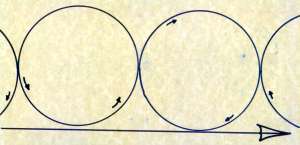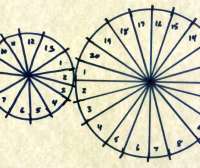Aztec Calendar Wheels
The Aztec calendar wheels have been a source of fascination for centuries. It wasn't just a way to keep time - it was a complete philosophy of time. The Aztecs felt that there was religious significance in every day. They also believed that time went in cycles - ultimately in the repeated destruction and recreation of the world.
The Aztecs weren't the only people that thought this way. Many peoples around the world have thought of time as cyclic. The belief in reincarnation, for example, is a reflection of this - and the idea of karma ("what goes around comes around"). In contrast, a linear system has a progression (as in Darwin's concept of evolution) and/or an end or consummation (as in the Christian concept of time). The idea of cycles of time was common in Mesoamerica for hundreds of years. The Aztec calendar was a variation of earlier calendars, such as the well known (and extremely accurate) ancient Mayan calendar.
Of course, many people today combine the two systems of time, which is possible if you imagine that there is repetition in time, but it has an ultimate end (or it's ultimately in cycles, but there are long "linear" periods).

The roots of the Aztec calendar wheels
The earliest calendars in Mesoamerica used a 260 day cycle, as did the Aztec calendars. Not only was it the basis for the ancient Mayan calendar, but also the calendars of the Olmec, Toltec, Zapotec, and many more.
It could be argued that the system reached its height in the ancient Mayan calendar. Their system was used to keep their many records. It was also used to plan events - to ensure that everyone used "lucky" and "unlucky" days to their advantage. E. G. Richards, in his book Mapping Time (see below), tells of one prisoner captured by the Mayans who had to remain on "death row" for 12 years while he waited for a proper conjunction of Venus for his execution! (The calendar was not always directly tied to the movement of the planets (as is claimed in astrology), but they did use the planets to measure time.)
How the Aztec calendar wheels work
When you think of a mechanical clock, you can see that the idea of a calendar wheel is not so unusual. A mechanical clock has gears, like the gears on a bike. A smaller gear (or wheel) moves a larger gear. That's basically how the Aztec calendar wheels work.
There are, in a sense, three wheels in the Aztec system, each representing a different calendar. There was a 260 day cycle, a 365 day cycle, and a 52 year cycle - three "wheels" that worked together.
The Aztec date-keeping was sometimes less precise than the Mayan system. For example, a certain date could refer to a couple of different times in a year. To this day there is disagreement about when events occurred in the Aztec empire, for this very reason.
The tonalpohualli
 |
The 260 day system was called the tonalpohualli. It was broken up into 20 periods of 13 days (trecenas) each (20x13=260). Each period had a name, and each of the 13 days had a name. This was a religious calendar, which the priests used to find the luckiest days for various activities. The Aztecs weren't concerned that the years (or 260 days) always coincide with the seasons (their years "wandered").
This calendar can be imagined as two interlocking wheels, one with the numbers 1-20, or in this case 20 symbols, and another with the numbers 1-13. On the first day you have the first symbol and the number 1. After 14 days, you're on number 1 and symbol 14. After 21 days, you're at number 8 and symbol 1. And so on.
We don't know how this cycle came into being. It has been suggested that the period of 260 days is close to the length of human pregnancy.
See a picture of Aztec calendar wheels from Smith College.
The xiuhpohualli
The year count was called the xiuhpohualli. This was actually kept to the 365 day count that we're more familiar with. Naturally, this was more related to the seasons, and so was used as an agricultural calendar. It was divided into 18 periods (meztli), 20 days (veintenas) each. 18x20=360. Yes, 5 days were left over. These were called nemontemi, and they were festival days. This calendar was also used for ceremonies and festivals. This can be imagined as a wheel with 20 and another with 18, except that every 360 days the wheel is "reset" for 5 days.
A wheel within a wheel
But there are actually 3 Aztec calendar wheels - there is a third big wheel called the calendar round. The two major cycles (the tonalpohualli and the xiuhpohualli) were interlocking, and every 52 years they would align again. This was a sort of Aztec "century", and was a reason for more religious celebration. Any day in this system (used by the Mayans and Aztecs) would not be repeated for 18,980 day, or, 52 years. You can read more about Aztec religious festivals here.
Further reading
A good explanation of Aztec calendar wheels can be found here. This page also gives information about the ancient Mayan calendar. For a simpler summary, read this this introduction to the Aztec calendars. Here you can see the names of the various symbols. Read more about the so-called Aztec calendar stone here. Finally, find out a little more about the background and uses of the Aztec calendar here.
We are thankful to the insights of E. G. Richards in Mapping Time: The Calendar and Its History. Also try the The Aztec Calendar Handbook by Randall C. Jimenez and Richard B. Graeber.
Linear or cyclical?
Although the Mesoamerican peoples did believe in cyclic time, they also measured longer periods of linear time, and at times believed in an end to the cycles. Still, their day-to-day life was much more focused on the cycles, from birth to death. The Aztec calendar wheels weren't just a theoretical idea, they were used frequently in everyday life.